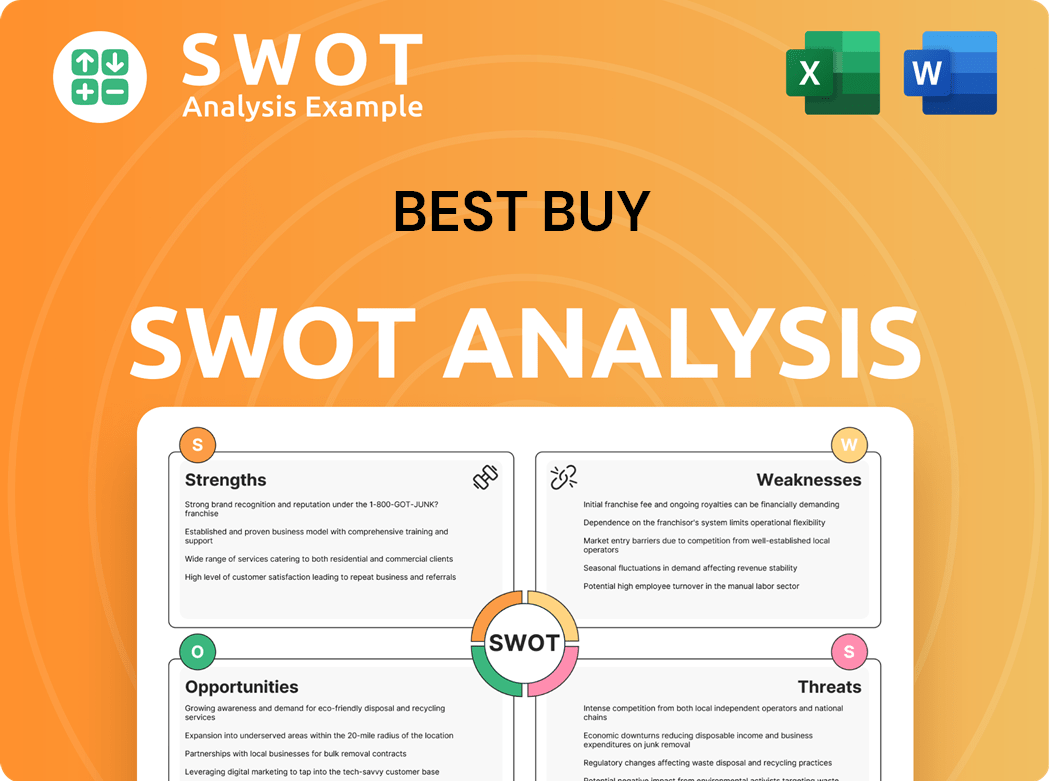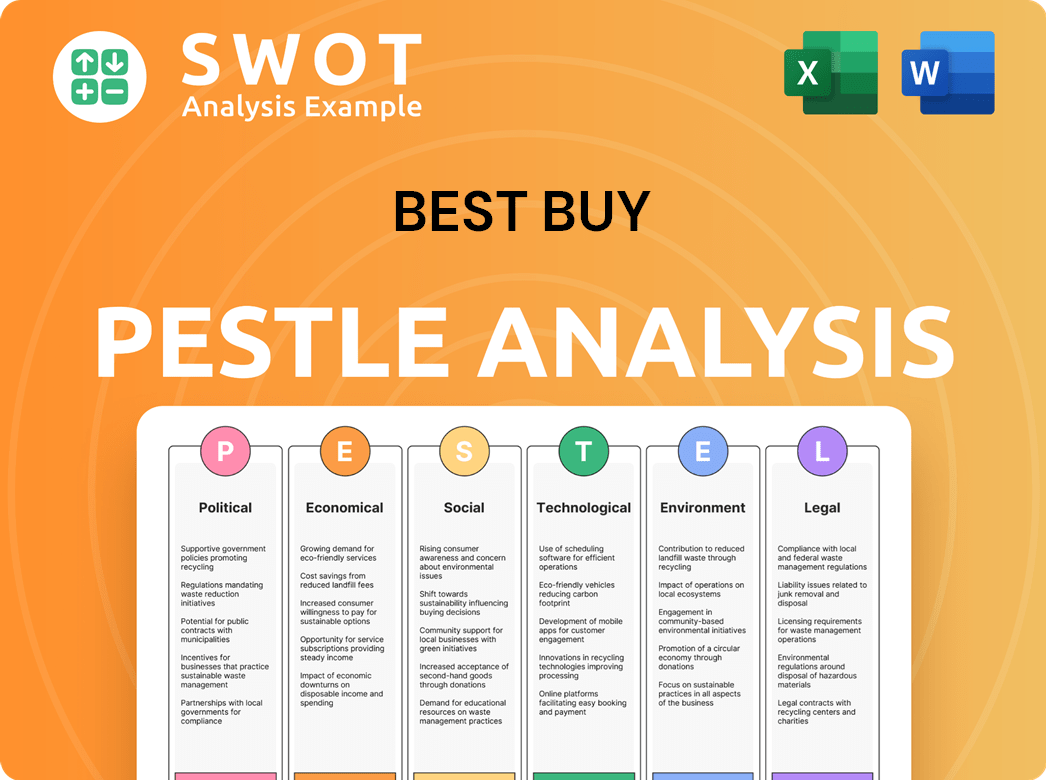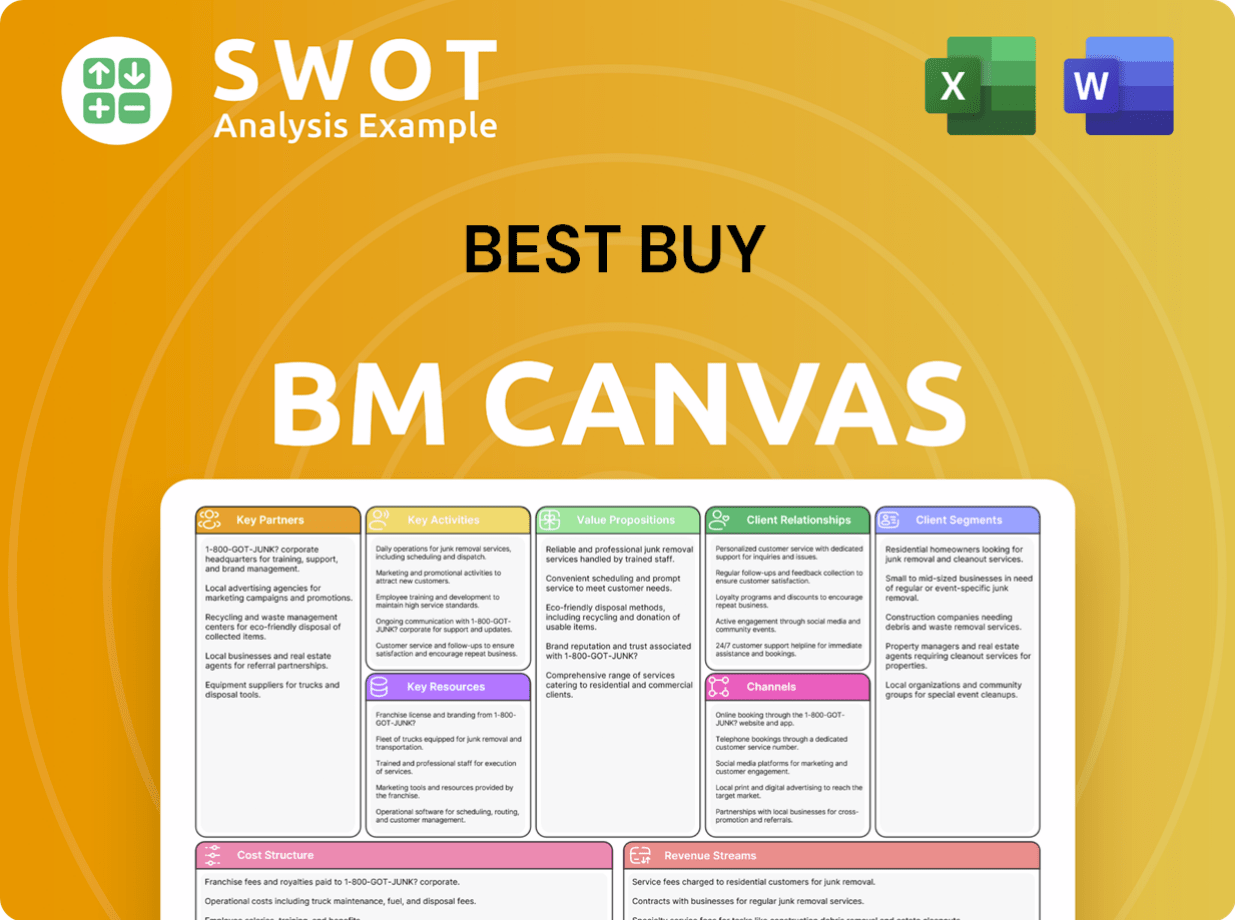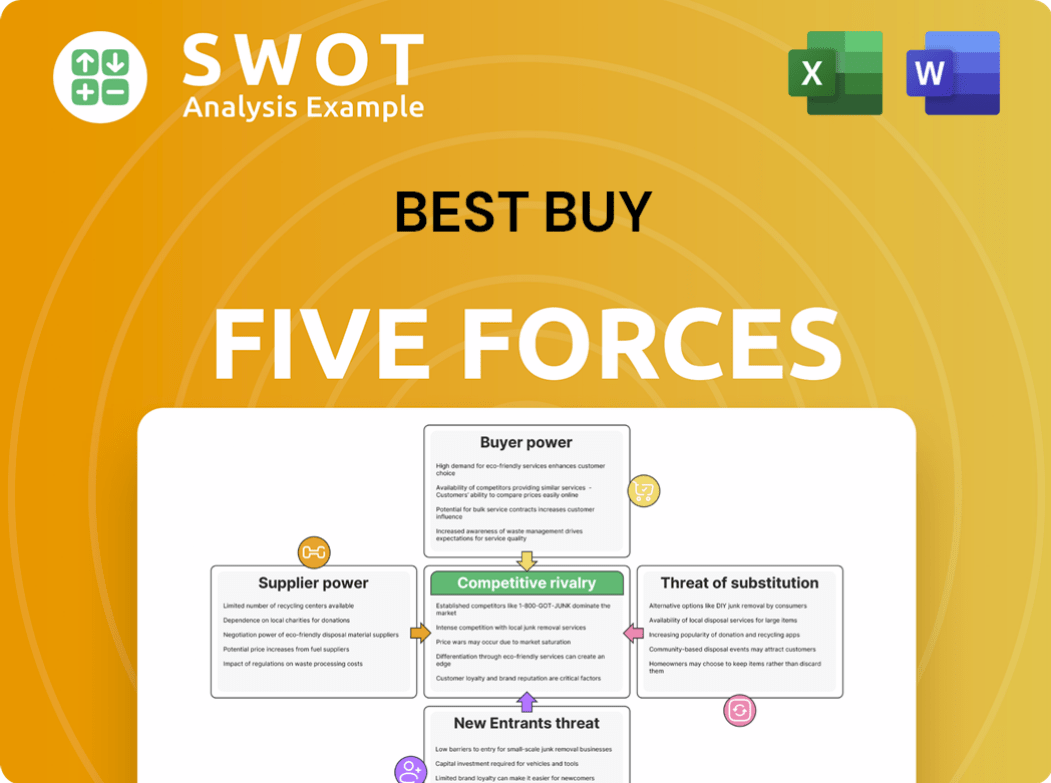Best Buy Bundle
How Does Best Buy Thrive in a Cutthroat Market?
The consumer electronics arena is a battlefield of innovation and consumer demand, where giants clash for dominance. Best Buy, a stalwart in this landscape, has carved a significant presence since its inception in 1966. Understanding the Best Buy SWOT Analysis is crucial to grasping its strategic positioning.

From its beginnings as a specialized audio retailer, Best Buy has evolved into a comprehensive consumer electronics destination, facing intense competition. This analysis delves into the dynamic Best Buy competitive landscape, examining its key Best Buy competitors and strategies. We'll explore the Best Buy market analysis to understand how it competes with online retailers and maintains its market share in the face of the ever-changing retail industry competition.
Where Does Best Buy’ Stand in the Current Market?
Best Buy holds a significant market position within the consumer electronics retail industry, particularly in North America. The company's core operations center around the sale of a wide array of consumer electronics, appliances, and related services. This includes everything from televisions and computers to mobile phones and home theater systems, alongside major appliances and tech support through its Geek Squad arm.
The company's value proposition revolves around providing a comprehensive retail experience, combining product sales with expert advice and service. Best Buy aims to differentiate itself from online-only retailers by offering in-store experiences, knowledgeable staff, and after-sales support, such as installation and repair services. This strategy is designed to create a customer-centric approach, emphasizing value beyond just price.
Best Buy's geographic presence is concentrated in the United States, Canada, and Mexico. The company operates a large network of physical stores and leverages its e-commerce platforms to serve a broad customer base. This dual approach allows it to cater to diverse consumer preferences, offering both the convenience of online shopping and the in-store experience.
Best Buy has historically held a leading or significant market share in various segments of consumer electronics and appliances. While specific market share figures for 2024-2025 are subject to ongoing market analysis, the company's strong presence in the U.S. market is evident. The company's financial performance, with total revenue reaching $43.45 billion in fiscal year 2024, reflects its significant operational footprint.
Best Buy has strategically adapted to changing retail dynamics by emphasizing a differentiated in-store experience, expert advice, and comprehensive service offerings. This approach aims to counteract the price-driven competition from online retailers. The company has also expanded its service offerings, which are becoming an increasingly important revenue stream.
Best Buy demonstrates considerable scale, which allows it to invest in strategic initiatives, including digital transformation and supply chain optimization. The company's financial health is crucial for maintaining its competitive edge and adapting to market changes. Understanding the financial performance of Best Buy compared to its competitors is key to assessing its market position.
While Best Buy holds a strong position in the U.S. market, its international footprint is more focused on Canada and Mexico. This indicates a concentrated regional strength rather than a broad global presence. The company's expansion plans and market growth are primarily centered within these regions.
Best Buy's competitive landscape involves navigating both physical and online retail environments. The company's strategies to stay competitive include enhancing customer service, expanding service offerings, and optimizing its supply chain. For more insights into the company's financial structure, consider reading about Owners & Shareholders of Best Buy.
- Emphasis on in-store experience to compete with online retailers.
- Diversification into services, such as installation and repair, to boost revenue.
- Strategic investments in digital transformation and supply chain optimization.
- Focused geographic presence in North America.
Best Buy SWOT Analysis
- Complete SWOT Breakdown
- Fully Customizable
- Editable in Excel & Word
- Professional Formatting
- Investor-Ready Format

Who Are the Main Competitors Challenging Best Buy?
The Best Buy competitive landscape is multifaceted, with the company facing competition from a variety of players in the retail and e-commerce sectors. Understanding the dynamics of these competitors is crucial for assessing the company's market position and strategic challenges. This involves analyzing both direct and indirect competitors, their market strategies, and their impact on Best Buy's performance.
The Best Buy market analysis reveals a complex environment where the company must continually adapt to maintain its competitive edge. The rise of e-commerce, changing consumer preferences, and the strategies of key rivals all play significant roles in shaping Best Buy's future. Analyzing these factors provides insights into the company's strengths, weaknesses, opportunities, and threats.
Direct competitors include large-format retailers and e-commerce giants that offer a wide range of consumer electronics. These competitors often have significant market share and aggressive pricing strategies.
Amazon is a formidable competitor due to its vast online marketplace, competitive pricing, extensive product selection, and rapid delivery services. Amazon's dominance in e-commerce poses a significant challenge to Best Buy's physical store model. In 2024, Amazon's net sales in North America reached approximately $315.4 billion, highlighting its substantial market presence.
Walmart and Target compete directly by offering electronics departments within their hypermarket formats. They often use competitive pricing to attract a broad consumer base. Walmart's electronics sales in 2024 were estimated to be around $40 billion, reflecting its significant presence in the consumer electronics market.
Specialized electronics retailers, though fewer in number, also pose a threat. These retailers cater to niche segments, offering specialized components and expert advice. Micro Center is an example of this type of competitor.
Indirect competitors include telecommunications companies and manufacturers selling directly to consumers. These competitors challenge Best Buy by reducing its role as an intermediary.
Telecommunications companies like AT&T, Verizon, and T-Mobile compete in the mobile phone and connected device space. They often bundle devices with their service plans. In 2024, the mobile phone market saw significant competition, with these companies offering attractive deals to consumers.
Manufacturers like Apple, Samsung, and Dell sell directly to consumers through their websites and branded stores. This trend reduces Best Buy's role as an intermediary. Apple's DTC sales in 2024 accounted for a substantial portion of its revenue, highlighting the impact of this strategy.
The retail industry competition is intense, with electronics market share being a key battleground. Best Buy must continually adapt its strategies to compete effectively. Understanding who are Best Buy's main rivals is crucial for developing effective competitive strategies. For example, examining Best Buy's competitive advantages and disadvantages helps in formulating targeted responses to market challenges. A detailed analysis of market share of Best Buy compared to Amazon reveals the extent of the competitive pressure. Furthermore, studying how does Best Buy compete with online retailers provides insights into its strategic initiatives. For more information about Best Buy's target market, you can read this article about the Target Market of Best Buy.
Best Buy's ability to compete depends on several factors. These include pricing, product selection, customer service, and the effectiveness of its online and physical store presence.
- Pricing: Best Buy competes with Amazon and other retailers through price matching and promotional offers.
- Product Selection: Offering a wide range of products, including exclusive items, is crucial.
- Customer Service: Providing expert advice and support differentiates Best Buy from competitors.
- Online Presence: A user-friendly website and efficient online ordering and delivery are essential.
- Physical Stores: Leveraging its physical stores for product demonstrations, in-store pickup, and customer service.
Best Buy PESTLE Analysis
- Covers All 6 PESTLE Categories
- No Research Needed – Save Hours of Work
- Built by Experts, Trusted by Consultants
- Instant Download, Ready to Use
- 100% Editable, Fully Customizable

What Gives Best Buy a Competitive Edge Over Its Rivals?
Understanding the competitive landscape for consumer electronics retailers requires a deep dive into companies like Best Buy. The company's ability to maintain a strong market position hinges on its competitive advantages. Analyzing these strengths is crucial for investors and business strategists alike, providing insights into its long-term viability. This analysis helps to understand how Best Buy navigates the challenges of the retail industry competition.
Key to this analysis is examining Best Buy's strategies to stay competitive, including its omnichannel approach and customer service offerings. The company's financial performance compared to competitors is also a critical factor. This includes looking at its market share and how it leverages its physical store presence alongside its online platform. Moreover, understanding the impact of e-commerce on Best Buy's business model is essential for a comprehensive market analysis.
Best Buy's competitive advantages are multifaceted, allowing it to differentiate itself in a crowded market. A significant advantage lies in its extensive physical retail footprint combined with a robust e-commerce platform, offering customers the flexibility of omnichannel shopping. This allows Best Buy to provide a tangible product experience, immediate gratification for purchases, and convenient in-store services that online-only retailers cannot replicate. The company's 'store-as-a-hub' strategy further leverages its physical locations for online order fulfillment, returns, and customer support.
Best Buy operates a vast network of stores, providing a tangible shopping experience. This physical presence is a key differentiator against online-only retailers. The integration of its online platform with its physical stores allows for seamless order fulfillment and returns.
The Geek Squad offers installation, repair, and technical support services. This proprietary service arm fosters customer loyalty and provides a crucial revenue stream. The expertise of Geek Squad agents differentiates Best Buy from competitors who may only offer basic product sales.
Best Buy benefits from strong relationships with major consumer electronics brands. These relationships often secure exclusive product launches or favorable pricing. Its brand equity, built over decades, signifies trust and reliability in the consumer electronics space.
The company has invested in its supply chain and logistics, enabling efficient inventory management and product distribution. This efficiency helps in managing costs and ensuring timely product delivery. This is crucial in the competitive retail industry.
Best Buy's competitive advantages are a mix of physical presence, expert services, and brand relationships. These advantages allow the company to compete effectively in the electronics market. Understanding these aspects is key to performing a thorough Best Buy market analysis.
- Omnichannel Strategy: Combining physical stores with a strong online presence.
- Geek Squad: Offering specialized technical support and services.
- Brand Relationships: Securing exclusive product launches and favorable pricing.
- Supply Chain Efficiency: Ensuring timely product delivery and inventory management.
While Best Buy faces ongoing threats from price competition and evolving consumer behaviors, its combination of physical presence, expert services, strong brand relationships, and established brand equity provides sustainable advantages in the competitive landscape. For more insights into how Best Buy generates revenue, consider reading about the Revenue Streams & Business Model of Best Buy.
Best Buy Business Model Canvas
- Complete 9-Block Business Model Canvas
- Effortlessly Communicate Your Business Strategy
- Investor-Ready BMC Format
- 100% Editable and Customizable
- Clear and Structured Layout

What Industry Trends Are Reshaping Best Buy’s Competitive Landscape?
The consumer electronics retail industry is dynamic, influenced by rapid technological advancements, changing consumer behaviors, and intense competition. The Best Buy competitive landscape is shaped by these factors, requiring the company to continually adapt its strategies to maintain its market position. Understanding the industry trends, future challenges, and opportunities is crucial for assessing its long-term viability.
The retail industry competition is fierce, with both online and brick-and-mortar retailers vying for market share. Best Buy market analysis reveals a need for strategic agility to navigate the evolving landscape. The company must address challenges such as e-commerce pressure and shifting consumer preferences while capitalizing on opportunities in emerging technologies and services.
Technological innovation is a primary driver, with AI, smart home devices, and VR creating new product categories. Sustainability and ethical sourcing are increasingly important to consumers. The shift towards online purchasing and the demand for convenience are reshaping retail strategies. Regulatory changes, including data privacy and e-waste, impact operations.
Ongoing pressure from e-commerce, which drives price competition and changes consumer habits. Declining demand in mature product categories and increased regulation pose risks. New competitors entering niche segments add to the competitive intensity. Maintaining a seamless omnichannel experience is vital for survival.
Capitalizing on the demand for smart home integration and services, leveraging expertise. Expanding offerings in emerging technologies and sustainable products aligns with consumer preferences. Strategic partnerships with tech companies can unlock new revenue streams. Focusing on personalized customer engagement and services strengthens the value proposition.
Enhancing the omnichannel experience by integrating online and in-store services. Focusing on services, personalized customer engagement, and a seamless online and in-store experience. Investing in employee training to support new technologies and services. Developing robust supply chain and logistics to meet consumer demands.
The Best Buy competitive landscape is significantly influenced by its ability to adapt to the changing market dynamics. The company's strategy includes a focus on services, such as the Geek Squad, and a strong omnichannel presence. For a deeper dive into how the company is approaching growth, consider reading the Growth Strategy of Best Buy. The company's financial performance, compared to its competitors, is a key indicator of its success in navigating these challenges.
The market is influenced by rapid technological advancements and shifting consumer preferences. E-commerce continues to drive price competition and change purchasing habits. Sustainability and ethical sourcing are increasingly important to consumers.
- Electronics market share is constantly shifting due to online retailers and changing consumer preferences.
- Best Buy's competitive advantages and disadvantages are shaped by its ability to adapt to these changes.
- Best Buy's strategies to stay competitive include enhancing its omnichannel experience and expanding services.
- Analysis of Best Buy's pricing strategy reveals a focus on competitive pricing and value-added services.
Best Buy Porter's Five Forces Analysis
- Covers All 5 Competitive Forces in Detail
- Structured for Consultants, Students, and Founders
- 100% Editable in Microsoft Word & Excel
- Instant Digital Download – Use Immediately
- Compatible with Mac & PC – Fully Unlocked

Related Blogs
- What are Mission Vision & Core Values of Best Buy Company?
- What is Growth Strategy and Future Prospects of Best Buy Company?
- How Does Best Buy Company Work?
- What is Sales and Marketing Strategy of Best Buy Company?
- What is Brief History of Best Buy Company?
- Who Owns Best Buy Company?
- What is Customer Demographics and Target Market of Best Buy Company?
Disclaimer
All information, articles, and product details provided on this website are for general informational and educational purposes only. We do not claim any ownership over, nor do we intend to infringe upon, any trademarks, copyrights, logos, brand names, or other intellectual property mentioned or depicted on this site. Such intellectual property remains the property of its respective owners, and any references here are made solely for identification or informational purposes, without implying any affiliation, endorsement, or partnership.
We make no representations or warranties, express or implied, regarding the accuracy, completeness, or suitability of any content or products presented. Nothing on this website should be construed as legal, tax, investment, financial, medical, or other professional advice. In addition, no part of this site—including articles or product references—constitutes a solicitation, recommendation, endorsement, advertisement, or offer to buy or sell any securities, franchises, or other financial instruments, particularly in jurisdictions where such activity would be unlawful.
All content is of a general nature and may not address the specific circumstances of any individual or entity. It is not a substitute for professional advice or services. Any actions you take based on the information provided here are strictly at your own risk. You accept full responsibility for any decisions or outcomes arising from your use of this website and agree to release us from any liability in connection with your use of, or reliance upon, the content or products found herein.